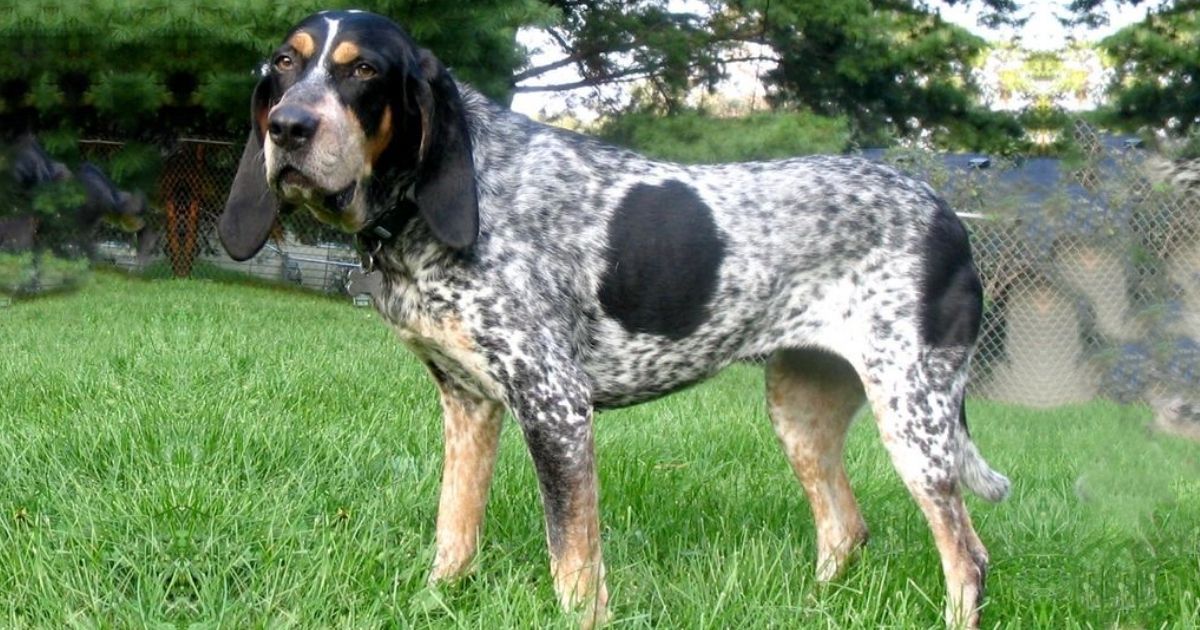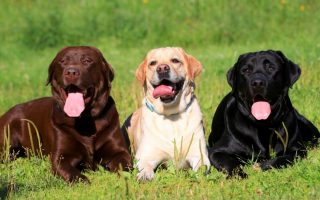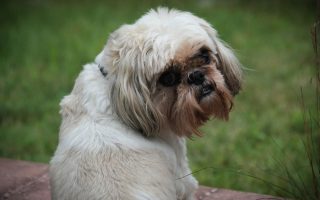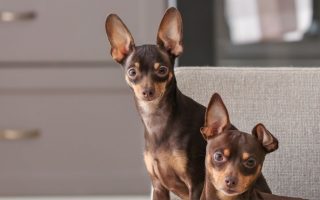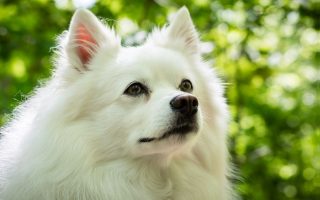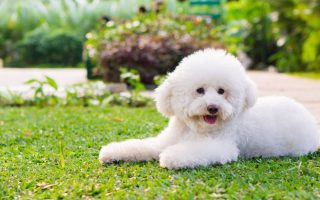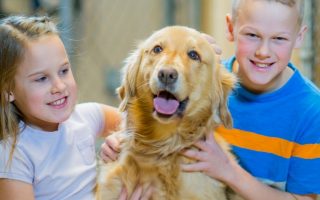The Bluetick Coonhound is one of the Coonhound species which originated in the United States in the 18th century.
Originally, the Bluetick Coonhound dog breed was used in hunting raccoons, hence the term coon-hound.
However, in recent times, it has been bred as a friendly family dog, and it has several lovable characteristics such as playfulness, intelligence, affection, and other positive attributes.
The Bluetick Coonhound looks quite athletic, and its physical appearance can discourage one from getting it.
However, the dog exhibits many homely attitudes that will have a naive prospective owner rethink their original decision not to have it.
This article covers all the interesting information you should know about the Bluetick Coonhound facts, characteristics, temperament, behavior, gender differences, and exciting features to help you decide if this is the right dog for you.
Key Bluetick Coonhound Facts and Information
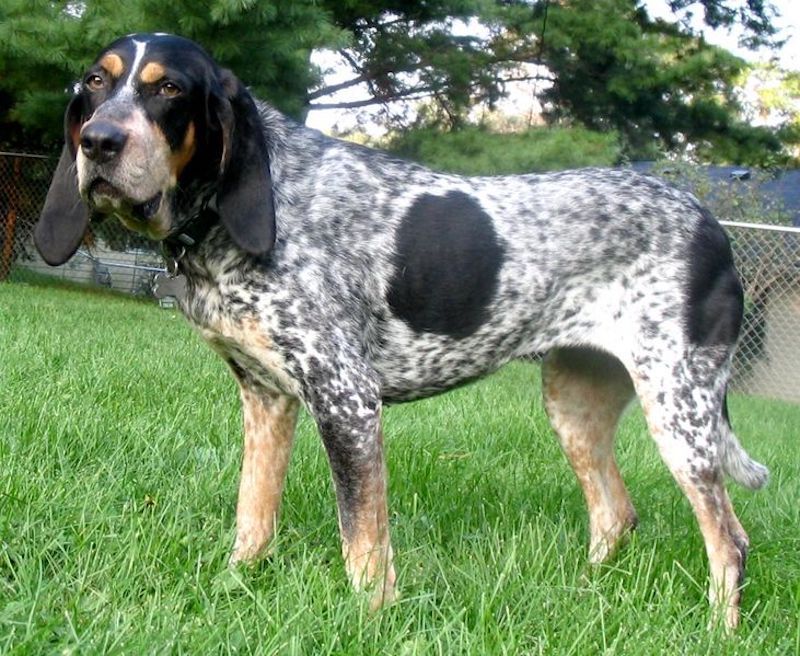
| Dog Breed Group | Hound Group |
| Height | Dogs: 22 to 27 in; Bitches: 21 to 25 in |
| Weight | Dogs: 25–36 kg; Bitches: 20 to 29 kg |
| Coat | Short and smooth |
| Color(s) | Mottled blue |
| Life Expectancy | 11 – 12 years |
| Temperament / Behavior | Intelligent, friendly, active |
| Origin | United States |
| Bred For | Raccoon hunting |
| Nickname(s) / Other Name(s) | N/A |
| Recognized by the AKC and UKC | Yes |
Bluetick Coonhound Characteristics
| Adaptability | Adapts well to an environment with lots of space to explore |
| Friendliness | Affectionate to family and strangers |
| Kid-Friendly | Very friendly with kids |
| Pet-Friendly | Can be unfriendly towards smaller pets |
| General Health | Generally healthy but may suffer from bloating |
| Grooming Needs | Easy to groom |
| Trainability | Relatively easy to train |
| Intelligence | Very intelligent breed |
| Playfulness | Loves to play |
| Exercise Needs | Needs an average of one hour of exercise daily |
| Energy Level | Very high energy level |
| Tendency to Bark | Barks a lot |
| Tendency to Drool | Drools sometimes |
| Tendency to Snore | Snores sometimes |
| Tendency to Dig | Digs sometimes |
Interesting Facts About the Bluetick Coonhound Dog Breed
Fact #1: They have strong protective instincts
The Bluetick Coonhound is known for its strong protective instincts.
If a stranger comes up to its habitat, it “welcomes” the stranger with lots of sniffing and howling until it is satisfied that the stranger means no harm.
They “howl” (or bay) up a storm when its instincts do not recognize harmlessness on the part of the stranger.
The Bluetick Coonhound is fiercely loyal to their host family and would likely give their life for them. They make good guard dogs as well as excellent pet dogs.
Fact #2: They are different from American English Coonhounds (Redtick Coonhound)
While both species can be said to be members of the same breed, they are distinctly different despite some similarities in their appearance.
Below are some similarities and differences that can help you tell them apart:
Similarities:
- They both have floppy ears.
- They were both bred primarily for raccoon hunting.
- They are both purebred dogs.
Differences:
- The Redtick Coonhound has varying colors, while the Bluetick Coonhound has just one color variant.
- While the coat of the Redtick coonhound is hard, that of the Bluetick coonhound is fine.
These and more are noticeable differences that can be used to tell the Bluetick and Redtick Coonhounds apart.
Fact #3: They express their boredom by destructive chewing
The Bluetick Coonhound needs a lot of running exercise due to its in-bred nature of chasing raccoons.
Therefore, when they are unable to exercise for a long period, they can resort to destructive chewing as a means of passing their feelings across to their owner.
It is not uncommon to find them baying unnecessarily at these periods when they are bored.
To prevent your Coonhound from destructive chewing, ensure they get quality exercise hours.
It helps if you have an active family and space in your environment where the dog can exercise and kids who like to play, although this is not a criterion, and your pet can still have an active life without kids.
Fact #4: They like to express their dominance over smaller animals
The Bluetick Coonhound are natural hunters, so leaving them with smaller animals might be a mistake.
This is likely to activate their predator sense or “high prey drive,” leading to aggressive behavior.
Therefore, it might not be good to have the Bluetick Coonhound in the same house with cats, hamsters, and other smaller pets.
You might find yourself missing one animal, and it won’t be the Bluetick Coonhound.
Fact #5: They are not actually blue
While this might come as a shock to some by the name “Bluetick Coonhound,” it is essential to know that this dog species isn’t actually blue.
It does happen that the Bluetick Coonhound has an appearance that looks somewhat blue.
In fact, they are majorly colored white and black. It only so happens that the black spots against the white background appear to be a shade of blue referred to as navy blue.
Bluetick Coonhound History and Origin
The Bluetick Coonhound was first bred in Louisiana back in the 18th century from about six different species: the American Foxhound, the cur dog, and others.
Initially, Bluetick Coonhounds were registered in the United Kennel Club under the English Foxhound and Coonhound as a variant.
However, they were recognized by the club as a separate breed in 1946.
Bluetick Coonhounds are recognized by the American Kennel Club and the United Kennel Club.
However, they were not allowed to compete in the AKC Coonhound events until December 2009.
The Bluetick Coonhounds were originally bred to be hunting companions to hunt raccoons.
However, they have been able to be bred as household pets and not just hunting dogs.
Bluetick Coonhound Temperament, Behaviour and Intelligence
The Bluetick Coonhound is an active, intelligent breed of dog.
Initially bred as hunting companions, the Bluetick Coonhound are excellent guard dogs and would make a plausible friend for a human that loves to explore the great outdoors.
You may call them sleek and racy, but they are never chunky or clumsy.
The Bluetick Coonhound would require a home with lots of space for adequate exercise and run-around as a family pet.
When bored, the Bluetick Coonhounds are known to take to destructive chewing, make long baying sounds, and even develop several diseases!
As a result of being trained specially to hunt smaller animals like raccoons, this species has a tremendous prey drive.
They are known to welcome visitors or strangers with loud baying and excessive sniffing until they’re satisfied.
When push comes to shove, they’re fiercely loyal and are prepared to give their heart to their loved ones.
Are Bluetick Coonhounds good family dogs?
Bluetick Coonhounds are active, intelligent, loyal, and loveable. When properly trained, they are known to be accommodating to other animals and strangers and tend to be overprotective of their loved ones.
Although the Bluetick Coonhounds were originally bred for hunting, they make excellent family dogs in an active home. They are relatively easy to train and fun to be around.
They are usually not aggressive except when provoked, and when this happens, they are well prepared to lay down their life and go all out for their family.
Bluetick Coonhounds prefer temperate climates (not too cold, not too hot) and, due to their energy level, require a home that affords ample space for daily exercise.
Are Bluetick Coonhounds good with kids?
Smart, devoted, and wary of strangers, the Bluetick Coonhound might just be your best bet at giving your kids fun and active playtime while keeping creeps at bay.
They are very good with kids if properly trained and can get along well with children—and if the child is active and loves playing around, all the better.
However, considering the health hazards of rough play, it might be advisable to get an adult dog instead of a pup.
The varying energy levels make all the difference when considering the extremities of the games they might play. The energy level of a pup is usually greater than that of an adult.
Are Bluetick Coonhounds good with other pets?
While this essentially boils down to socialization, upbringing, and litter time with other pups, Bluetick Coonhounds were bred to hunt raccoons. As such, they have a high prey drive towards smaller pets, and it might not be advisable to leave them together unattended.
This is especially true for animals like hamsters and other pets that may look similar.
However, your Coonhound can get along well with other animals is if they were all brought home at the same time.
This way, your dog would see the other animals as part of the pack, thus fostering a cordial relationship between them.
Are Bluetick Coonhounds good with other dogs?
Considering their hunting history in packs, the Bluetick Coonhound can get along well with other dogs, especially if they see the other dog(s) as a part of the pack.
This is especially true if they are of the same or similar sizes. However, In rare cases, they might feel a need to pick on the other smaller dogs.
Male Vs Female Bluetick Coonhound
Choosing a male or female Bluetick Coonhound is a matter of preference.
Apart from the apparent reproductive organ differences between the male and the female dogs, the male Bluetick Coonhound is visibly bigger and weighs more than the female.
The male weighs about 25–36 kg, with a height of 22–27 in, while the female weighs 20–29 kg, with 21–25 in.
Also, as with most male dogs, irrespective of the breed, the male Bluetick is usually more dominant while the female is calmer.
Caring for a Bluetick Coonhound
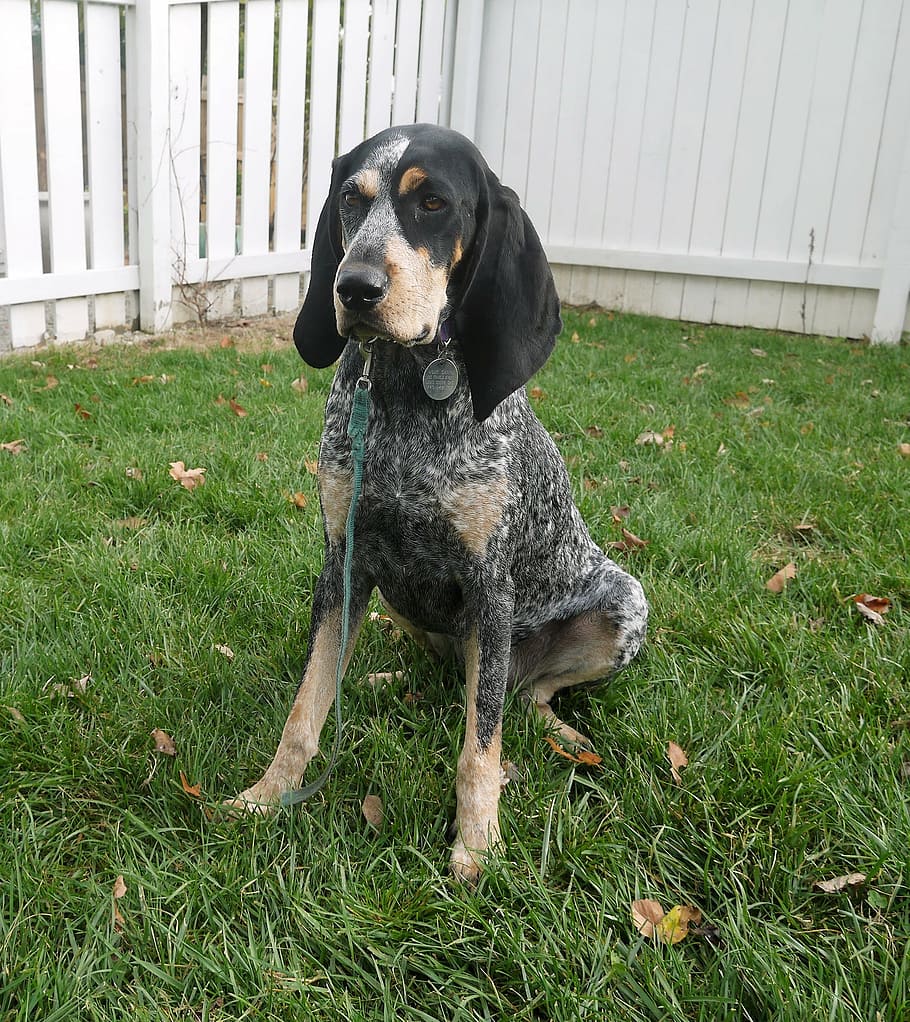
Bluetick Coonhound Food and Diet
Bluetick Coonhounds are known to get fat easily, and as such, from a young age, you should feed them with that knowledge.
Letting your dog become obese will open the door to lots of life-threatening health issues.
Therefore they should be fed food specifically rich in healthy fats, protein, calcium, and vegetables.
A rich diet in the right amounts is essential for your Bluetick Coonhound’s growth and development stages as pups, adults, and seniors.
Bluetick Coonhound Exercise
Bluetick Coonhounds need daily exercise to keep in good shape and prevent them from exhibiting unhealthy, aggressive, and destructive attitudes.
They are not that hard to exercise. While a yard is ideal and preferable, if you do not have a yard, you can always take them for a walk or run.
They are content to remain indoors as long as they are adequately exercised.
Because Bluetick Coonhounds are hunting dogs, they might need a few minutes out in the open a few minutes each day.
This helps calm their nerves, and if you don’t have a yard for them to play in and your home is not close to nature, you can always go to the park.
A park is an excellent option for your pet to have a fun time running around and releasing all of their pent-up energy.
When they become adults, a lot of their behavior is determined by how long they spent with their mums and the litter.
For example, a pup that spent between 6 and 8 weeks with the litter would have a pack orientation.
Thus, it would help it accommodate other pets if there are other pets at the new owner’s home.
On the other hand, a pup that left the litter earlier would find it hard to accommodate other animals.
They are likely to exert dominance and prey on smaller animals more frequently than the pup that stayed long with the litter.
Because Bluetick Coonhounds are not very easy to train, a long leash is needed to train them.
You should decide on a convenient word such as “come” or ” here” to call them back to you, and you are advised not to change the phrase.
You should start with a short leash, and as your dog responds better, you can increase it.
Particularly worthy of note is the fact that Bluetick Coonhounds have high energy levels and, as such, may play around a lot.
New pet parents that cannot match their energy level may wound up frustrated.
Remember that the earlier a pup begins training, the faster and easier it is to get it trained.
A puppy that is allowed a lot of excesses will grow to be spoiled and won’t listen to anything that you tell it.
Also, rewarding your dogs with treats when they do well makes training much easier.
Bluetick Coonhound Grooming Needs
Nails trimming
Bluetick Coonhounds require their nails to be trimmed regularly.
This is important because overly long nails make it difficult for them to walk well and can also lead to unnecessary injuries to your dog, you, and your kids.
Bathing
Apart from the “musty scent” that seems almost normal with scent hounds like the Bluetick Coonhounds, they don’t mainly emit offensive smells.
However, you can take the liberty of bathing them every week if you do not fancy the smell.
Coat grooming
Bluetick Coonhounds don’t shed a lot, and as such, you can brush their fur once every one or two weeks.
This helps to keep their shedding to the barest minimum if you’re bothered by the fur shedding.
Teeth brushing
When your dog goes for a long time without teeth brushing, they are prone to Periodontal disease.
This can cause your dog to lose teeth and can even cause more enormous complications. To avoid this, ensure to brush your dog’s teeth regularly. Bacteria cannot grow in clean places.
Bluetick Coonhound Health Conditions
Regular checking and adequate medical attention will actively prevent diseases in dogs and elongate your pet’s lifespan.
While Bluetick Coonhounds are generally healthy species, it is relatively common for them to get:
Ear Infections
Ear infections can occur as a result of their drooping ears.
This can be prevented by regular cleaning, checking, and swift action if anything out of the ordinary is noticed. Don’t hesitate to seek medical attention from your family vet.
Hip Dysplasia
While several factors can cause hip dysplasia, the primary cause is genetics.
Hip dysplasia is known to be a hereditary disease—when one or both parents of your Bluetick Coonhound had Hip dysplasia, then your dog might have it too.
Other factors include: abnormal weight (at various stages), excessive growth rate, wrong types of exercise, and nutrition can increase the chances of this genetic illness occurring.
Luxating Patellas
Luxating means “dislocation,” and patellas is the “kneecap”. While this dislocating kneecaps illness occurs in varying degrees in dogs, it is relatively uncommon.
However, it is essential to keep an eye on your dog and be gentle when performing certain activities that might be hard on their kneecaps and joints.
Gastric Torsion
Also referred to as bloating, gastric torsion is perhaps the most hazardous of all Bluetick Coonhound illnesses.
Bloating, when not quickly attended to, can cause death. So you must learn to watch out for the symptoms early.
FAQs
Is the Bluetick Coonhound right for you?
Bluetick Coonhounds dog breeds are loyal, playful, energetic, and intelligent.
If you are energetic (or have an active family), enjoy a little bit of nature exploring, own a home with easy access to nature, and lots of play space, then the Bluetick Coonhound might be a good fit for you and your family.
What is the Bluetick Coonhound known for?
Although bred to hunt raccoons, Bluetick Coonhounds are well known for their friendly persona (when appropriately trained), cold nose, and deep bawl mouth.
How big do Bluetick Coonhounds get?
A full-grown male should weigh between 25–36kg and grow as tall as 22–27in, while an adult female should weigh between 20–29kg and grow as tall as 21–25in.
Do Bluetick Coonhounds like to cuddle?
When properly trained, the energetic Bluetick Coonhound is a sweet household pet, and if they’re properly exercised, they are pretty cuddly.
Is it hard to train and care for a Bluetick Coonhound?
Bluetick Coonhounds are often known for their difficulty during training. However, post-training, they are relatively low-maintenance dogs. They only need grooming every other week, and feeding them is easy as well.
How long do Bluetick Coonhounds live?
Without major health complications and with adequate exercise and a good climate, Bluetick Coonhounds can live up to 11–12 years.
How much does Bluetick Coonhounds puppy cost?
From our findings, on average, Bluetick Coonhounds cost about $400 to $1200. An average Bluetick Coonhound puppy will cost $600 in the United States.
The price will vary depending on the breeder, location, the dog’s bloodline, color, and age, among other factors.
Do Bluetick Coonhounds shed a lot?
The Bluetick Coonhound’s short glossy coat only sheds moderately and can be controlled by weekly brushing. So you don’t have to worry about having hair everywhere in your home.
Do Bluetick Coonhounds smell bad?
From experience, Scent Hounds like Bluetick Coonhounds may have “a musty smell.” While this can be controlled by bathing, it is something you should be prepared to live with.
Bluetick Coonhounds don’t usually need regular bathing, except they have managed to get themselves into a particularly smelly mess.
Are Bluetick Coonhounds lazy?
To the regular observing eye, the Bluetick Coonhounds may be seen as lazy. However, people with experienced dog eyes would think differently.
As innate hunt dogs, the Bluetick Coonhounds prefer to save up all of their energy for hunting and prefer to sleep when not on the trail.
This is one of the reasons why daily exercise is essential. It gives them an avenue to spend all of their pent-up energy.
Final Thoughts
Owning this dog breed has its pros and cons, which is why we have brought you an adequately detailed article on Bluetick Coonhound facts and information.
The Bluetick is not suitable for you if you are a pet parent who has busy office life, is not active, and live in cramped areas.
Furthermore, a Bluetick Coonhound is not ideal for first-time dog parents due to its training needs.
Finally, we hope this article has helped inform you better about your choices.
Related:
Useful Resources:
Official American Bluetick Coonhound Dog Breed Information and Standards:
- American Kennel Club (AKC)
- United Kennel Club (UKC)
- Australian National Kennel Council (ANKC)

